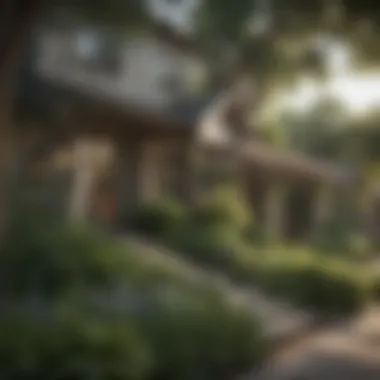Exploring Living Options in Austin, Texas


Intro
Austin, Texas is a city that captivates many with its vibrant culture and diverse living options. As an important hub for technology, music, and the arts, Austin provides unique neighborhoods that cater to various lifestyles. Whether you're a young professional, a family, or someone looking for retirement bliss, there are options to consider. This article aims to guide potential residents through the various aspects of living in Austin, including the neighborhoods, cultural dynamics, and the real estate market.
Understanding these elements will help you make an informed decision about where to plant your roots in this thriving metropolis.
Feature Spotlight
Exceptional Architectural Designs
Austin's architecture reflects a mix of modern innovation and historical significance. In neighborhoods like Zilker, you can find mid-century homes that have been lovingly restored, blending vintage charm with contemporary amenities. Detailed designs include expansive windows that invite natural light and promote outdoor views. In contrast, Downtown Austin showcases sleek high-rises boasting stunning views of the Texas State Capitol and Lady Bird Lake.
Unique Decor Elements
A significant aspect of Austin's living options is the personal touch residents infuse into their homes. Many people invest in local art, vibrant textiles, and eco-friendly materials. This reflects a commitment to both sustainability and style. For instance, in neighborhoods such as South Congress, you might find shops offering local crafts and decor, which supports Austin's artisanal culture. This adds richness to the living experience, transforming houses into personalized homes.
Location Highlights
Must-Visit Neighborhoods
Certain areas stand out as gems in Austin’s residential landscape.
- North Loop: Characterized by its indie shops and cafes, it has a laid-back vibe.
- Travis Heights: Known for its tree-lined streets and access to parks, ideal for families.
- Mueller: A modern development that combines residential living with retail, parks, and community spaces.
These neighborhoods each offer distinct atmospheres, which cater to various demographics.
Cultural and Historical Significance
Austin’s cultural heritage shapes its neighborhoods uniquely. The city is known for its music scene, whoch is deeply rooted in its history. Each area has its character, influenced by festivals and cultural events that occur throughout the year. For example, the West Campus area hosts a vibrant student population with easy access to the University of Texas.
In addition, neighborhoods like East Austin showcase a rich history tied to the African American community, marked by art and music that highlight its cultural contributions. This blend of history and culture fosters an enriching living experience.
"Choosing a neighborhood in Austin is about more than finding a house; it’s about finding a community that resonates with your lifestyle and values."
This exploration into the living options in Austin illustrates the city's diversity. From architectural appeal to cultural significance, Austin offers environments that cater to various lifestyles. Keep these aspects in mind as you consider relocating to this dynamic city.
Prologue to Austin Living
The choice of where to live is a monumental decision, shaped by various factors that vary for each individual. Austin, Texas, stands out as a compelling place to consider for both newcomers and long-time residents. Famed for its vibrant culture, thriving economy, and diverse neighborhoods, Austin offers an appeal that is difficult to overlook.
In understanding Austin's living options, it is paramount to examine several key aspects. Firstly, location matters immensely. The city is divided into multiple neighborhoods, each with its own unique characteristics. This diversity allows potential residents to find a suitable area that aligns with their lifestyle, whether they seek urban excitement or suburban tranquility.
When exploring lifestyle considerations, factors such as proximity to workplaces, schools, and recreational facilities become crucial. Austin’s economy is booming, particularly in technology and creative sectors. This influences the living preferences of professionals who are drawn to job opportunities in the area.
Additionally, the cultural significance of Austin enhances its livability. Known as the "Live Music Capital of the World," the city showcases a rich history of arts, music, and food. Engaging with the local culture fosters a sense of community and belonging that many seek in their living environments.
Real estate trends also play a significant role. As population grows, so does the demand for housing. Understanding current market dynamics and price ranges can aid potential residents in making informed decisions.
In summary, evaluating Austin as a living option involves a deep dive into its neighborhoods, lifestyle dynamics, and real estate environment. Each of these components enriches the decision-making process, ultimately aiding in the search for the right home in this dynamic city. Whether you're attracted by the cultural scene, job availability, or simply the ambiance, Austin presents a host of opportunities that warrant exploration.
City Overview
Understanding the city’s overview is essential for anyone considering a move to Austin. This city has an intricate blend of history, culture, and modern development that plays a significant role in defining its neighborhoods and lifestyle. Each aspect contributes to the attractiveness of Austin as a place to live.
Historical Context


Austin has a rich history that dates back to its establishment in 1839. Originally, it was named after Stephen F. Austin, known as the "Father of Texas." Over the decades, Austin transformed from a small settlement into a vibrant urban center. The city has retained many of its historical roots, seen in architecture and cultural practices. Historic buildings, such as the Texas State Capitol and the Littlefield House, offer glimpses into the past. This history is not only important for tourism but also adds character to the neighborhoods, making them unique and relatable.
Cultural Significance
Austin's culture is both diverse and dynamic. It is famously known as the "Live Music Capital of the World," showcasing a music scene that is unparalleled. Each year, the South by Southwest (SXSW) festival attracts visitors from around the globe, illustrating the city's cultural significance. The arts scene includes local galleries, theaters, and art installations that reflect Austin's community spirit. Cultural events such as the Texas Book Festival further establish Austin as a focal point for creativity and community engagement.
Current Demographics
The demographics of Austin present a fascinating picture of a city in evolution. As of 2023, the population has surged, with a mix of residents from various backgrounds and age groups. The tech industry plays a pivotal role, bringing in young professionals and families alike. Studies indicate that the tech sector attracts many also due to the presence of companies like Dell and the burgeoning startup scene. This influx impacts housing demand, schools, and local businesses.
The current trends point towards a more vibrant and youthful population, contributing to Austin's flourishing community dynamics.
Key Neighborhoods to Consider
Identifying the right neighborhood is a crucial step in finding a home in Austin. Each area offers a unique mix of culture, amenities, and community vibe that can significantly impact your living experience. From the vibrant city life of Downtown Austin to the tranquil charm of West Austin, exploring these neighborhoods can help you make informed choices tailored to your lifestyle and preferences.
Downtown Austin
Downtown Austin stands as the heart of the city, a dynamic hub buzzing with activity and cultural significance. This area is characterized by its high-rise buildings, eclectic dining options, and a rich arts scene. Residents benefit from proximity to major attractions such as the Texas State Capitol and the scenic Lady Bird Lake.
Being in the downtown area means access to a variety of events and festivals throughout the year. Furthermore, the public transportation options are abundant, enhancing the ease of commuting. However, prospective residents should consider the higher cost of living associated with downtown as it may not suit every budget.
South Austin
South Austin is known for its eclectic and laid-back atmosphere. This neighborhood embodies a unique blend of residential housing, parks, and local businesses that cater to a diverse community. Here, the vibrant music scene thrives, with live performances often taking over the local venues.
Families appreciate the abundance of parks and recreational spaces, as well as the strong sense of community found in this area. The local schools, such as Austin High School, are well-regarded. This part of Austin is generally more affordable than downtown, making it an attractive option for young professionals and families alike.
North Austin
North Austin offers a contrast to the busier city life found in the southern parts. Emphasizing a more suburban environment, it features spacious homes and family-friendly neighborhoods. Here, many parks and green spaces promote outdoor activities, making it ideal for those who prioritize recreation.
The tech industry has a notable presence in this area, contributing to its growing appeal for professionals. Neighborhoods like The Domain provide a blend of retail, dining, and living spaces, fostering a modern lifestyle. While housing costs are rising, residents still find it to be more affordable compared to other key neighborhoods.
East Austin
East Austin is a rapidly gentrifying area that retains a rich history and vibrant culture. Known for its diverse community, this neighborhood attracts artists and musicians, culminating in a lively arts scene. Local eateries and coffee shops bring a distinct personality to the area.
This neighborhood stands out for its creative vibe. It also offers new developments alongside traditional homes. For young creatives and professionals, East Austin serves as a canvas for expression and innovation. However, the demographic shifts bring challenges and opportunities, making it essential for new residents to adapt and engage with the community.
West Austin
West Austin is often lauded for its proximity to nature and scenic views. It boasts sprawling estates and quieter residential areas, appealing to families and retirees seeking peace and tranquility. Neighborhoods like Westlake Hills offer luxurious living amid lush landscapes and lakes.
Residents benefit from excellent schools and community facilities. Outdoor enthusiasts appreciate access to hiking trails and parks, making it an ideal setting for an active lifestyle. This neighborhood, however, tends to have higher property prices than other areas, reflecting its desirability.
Central Austin
Central Austin represents a blend of historical charm and modern convenience. This area features an array of home styles, ranging from vintage houses to contemporary lofts. Central Austin is often recognized for its livability due to easy access to parks, shops, and entertainment venues.
Residents enjoy a perfect mix of urban living with a neighborhood feel. Local favorites like Zilker Park and various cultural landmarks are within reach. The cost of living is moderate here, drawing a diverse range of residents who appreciate all that Central Austin has to offer.
Ultimately, each neighborhood contributes distinct attractions and challenges. Selecting the ideal neighborhood in Austin involves assessing personal needs, lifestyle habits, and budget considerations.
Lifestyle Considerations
Understanding lifestyle considerations is critical for anyone contemplating a move to Austin, Texas. This city offers a rich tapestry of living experiences, shaped by its diverse neighborhoods, amenities, and community feel. The importance of lifestyle elements cannot be overstated, as they profoundly influence day-to-day experiences. From urban vibrancy to suburban tranquility, each option carries its own set of perks and challenges.


Urban vs. Suburban Living
Urban living in Austin is characterized by proximity to city life. Residents often enjoy easy access to offices, entertainment venues, and a lively atmosphere. Areas like Downtown Austin are bustling with life, attracting those who thrive in energetic environments. Services and amenities abound here, making it appealing for those who prioritize convenience.
Conversely, suburban living in areas like Round Rock provides a different peace. These neighborhoods often feature larger homes and green spaces, making them suitable for families or individuals seeking a quieter lifestyle. It offers a refreshing escape from the hustle, but it may involve longer commutes to urban centers.
Family-friendly Neighborhoods
Family-friendly neighborhoods in Austin present unique benefits for parents and children alike. Areas like Cedar Park and Southwest Austin are often highlighted for their family-centric amenities, such as parks, schools, and community activities. These neighborhoods typically have lower crime rates, which adds to their appeal for families.
It is essential to consider schools in these areas. Strong educational facilities often foster a sense of community and support for children’s development. Programs for youth, outdoor spaces for play, and safe environments contribute to a positive upbringing.
Young Professionals' Hotspots
For young professionals, Austin offers several vibrant neighborhoods that cater to modern lifestyles. The domain of South Congress and East Austin attracts young residents with their trendy restaurants, bars, and social scenes. These areas often provide affordable housing options, especially for first-time buyers or renters.
Networking opportunities also thrive in these hotspots. The growing tech scene creates a competitive job market, making it a prime choice for ambitious individuals looking to expand their careers.
Retirement-friendly Areas
When considering retirement-friendly areas, one must evaluate community resources and recreational opportunities. Neighborhoods such as Sun City and parts of North Austin have gained recognition for their tailored amenities for retirees. These areas often provide well-established healthcare facilities along with social and recreational activities, cultivating a sense of community.
Moreover, safety, convenience, and accessibility to essential services play a significant role in selection. Retirees looking for peace and leisure will find Austin’s options to be thoroughly satisfying.
The decision between urban and suburban living is deeply personal. Factors like family needs, career ambitions, and lifestyle preferences all play pivotal roles in shaping this choice.
In summary, lifestyle considerations encompass a variety of elements that reflect personal needs and preferences. Whether leaning towards energetic urban life or serene suburban spaces, Austin offers a range of unique options suitable for different demographics.
Real Estate Market Analysis
Understanding the real estate market is crucial for anyone considering a move to Austin, Texas. An analysis of the market provides insights into property availability, current trends, and pricing, enabling potential residents to make informed decisions. The real estate landscape in Austin reflects the city’s growth, cultural vibrancy, and diverse living options.
Current Trends
The Austin real estate market is dynamic and influenced by various factors. Recently, there has been a significant increase in demand for homes due to the influx of new residents. Many people are drawn to Austin for its technology job market, cultural scene, and lifestyle. Moreover, homes in desirable neighborhoods are selling faster than in previous years. This quick turnover indicates a competitive market, prompting buyers to act swiftly.
Additionally, remote work flexibility has led families and young professionals to seek homes in suburban areas. As a result, neighborhoods that were once considered less desirable are becoming increasingly sought after.
It’s also important to note that the market has seen a rise in new constructions to meet demand. These developments often include modern amenities and energy-efficient features.
Property Types Available
Austin offers a broad array of property types to cater to varying tastes and budgets. Here are the main categories:
- Single-family homes: Predominantly found in suburban neighborhoods, they offer spacious layouts and yards.
- Condos and townhouses: These are popular in urban areas, appealing to those who prefer lower maintenance living.
- Luxury estates: For those seeking high-end living, areas like West Austin provide luxury homes with premium amenities.
- Apartments: There is a wide selection in different neighborhoods, serving students and young professionals.
Each property type comes with its unique set of features and price points, allowing various residents to find something that suits their lifestyle.
Price Comparisons by Neighborhood
Pricing in Austin varies greatly depending on the neighborhood. A comparison of different areas can shed light on where one can get the best value. Consider the following average price ranges per property type:
- Downtown Austin: High demand results in higher prices, where condos often start at $400,000.
- South Austin: A blend of affordability and urban culture with prices ranging from $300,000 to $500,000 for single-family homes.
- North Austin: Known for its family-friendly atmosphere, with average prices between $350,000 and $600,000.
- East Austin: A mix of older homes and new developments that hold pricing ranging from $400,000 to $700,000.
- West Austin: Luxury market commands prices often exceeding $1 million.
"Understanding these price differentials is vital for budget-conscious homebuyers."
When considering a move to Austin, a thorough real estate market analysis provides clarity on what to expect in terms of neighborhood characteristics and financial commitments. This comprehensive overview not only saves time but also aids in making strategic decisions for potential homebuyers. A clear grasp of the real estate landscape ensures that newcomers can effectively plan their transition to this vibrant city.


Amenities and Services
When considering where to live in Austin, understanding the amenities and services available is crucial. These factors can greatly affect daily life and overall satisfaction in a neighborhood. Access to quality schools, healthcare, and public transportation can elevate a community's appeal and convenience for residents. In this section, we will examine these essential services and their significance for potential residents.
Schools and Education
Education quality can vary widely across neighborhoods. Families particularly prioritize schools when choosing a place to live. Austin boasts numerous public and private educational institutions, including notable districts such as Austin Independent School District. Residents often seek out neighborhoods with high-performing schools to ensure children receive a solid education.
For those considering higher education, the presence of the University of Texas at Austin adds value. This institution provides a range of cultural experiences and activities, enriching the entire community. Furthermore, many neighborhoods have special programs or magnet schools that cater to specific talents or interests. Parents should also assess the availability of extracurricular activities, which are important aspects of a child's development.
Healthcare Facilities
Access to quality healthcare is another critical component when evaluating living options. Austin is home to many healthcare facilities, including hospitals and urgent care centers. Notable establishments include Seton Medical Center and St. David's Medical Center. The availability of healthcare services speaks not only to the quality of life but also to the safety and reliability of a neighborhood.
Residents should also look into specialized healthcare services, like pediatrics or geriatric care, depending on their needs. Proximity to medical clinics and availability of healthcare professionals can greatly influence daily routines, especially for families and the elderly. Being near wellness centers is also beneficial for those focused on a healthy lifestyle.
Public Transportation Options
Public transportation in Austin is essential for many residents, especially in urban areas. The city offers various routes operated by Capital Metro, including buses and MetroRapid services. These options provide connectivity to major employment centers, entertainment districts, and cultural venues.
For those interested in biking or walking, Austin also promotes alternative forms of transportation. Biking lanes and pedestrian-friendly paths help minimize reliance on cars, enhancing access to local amenities. This infrastructure supports a more sustainable lifestyle, which many residents appreciate. Evaluating public transit availability and quality can significantly influence residential choices, particularly for commuters or those seeking to reduce their carbon footprint.
"Accessibility to schools, healthcare, and public transit is not just about convenience; it shapes our community's quality of life."
In summary, when exploring living options in Austin, it's vital to think about the amenities and services within each neighborhood. Schools, healthcare facilities, and public transportation all contribute to the fabric of community life, guiding residents in their search for the perfect place to call home.
Cultural and Recreational Opportunities
Cultural and recreational opportunities shape the living experience in Austin. They foster community, support local businesses, and enhance quality of life. Understanding these elements is essential for potential residents. They can influence not only personal lifestyle choices but also property values in various neighborhoods. A vibrant cultural scene can attract a diverse population, while abundant recreational facilities can greatly impact family preferences.
Arts and Music Scene
Austin's identity as the "Live Music Capital of the World" cannot be overstated. The city thrives on its extensive live music offerings, hosting events such as South by Southwest and Austin City Limits Music Festival. Venues like the Moody Theater and The Continental Club are vital spaces for both emerging artists and established names. Local art galleries, such as the Blanton Museum of Art, provide a rich visual experience. This dynamic arts scene contributes significantly to the local economy and enhances cultural appreciation among residents.
Many neighborhoods are closely tied to specific cultural events. For instance, the South Congress area often features street fairs and art shows, while East Austin has a reputation for contemporary galleries and street art. For anyone considering a move, these cultural aspects not only enrich the local experience but also present opportunities for investment in areas likely to see continued growth.
Parks and Outdoor Activities
Austin boasts a variety of parks and natural spaces, making it ideal for outdoor enthusiasts. With over 300 days of sunshine per year, residents can enjoy activities year-round. Zilker Park, located near downtown, is perfect for picnics, kite flying, and music festivals. The Barton Springs Pool provides a refreshing escape on hot days; its natural spring water is a major attraction.
Moreover, the city is home to numerous trails, such as the Lady Bird Lake Hike-and-Bike Trail. This trail offers a scenic route for runners, cyclists, and walkers alike. Residents benefit from the proximity to nature, promoting a healthy lifestyle. Local neighborhoods often promote outdoor community events, such as yoga classes in the park or organized runs, making community engagement an integral part of life in Austin.
Dining and Nightlife
Austin's dining and nightlife scene is exceptional and contributes to its reputation as a culinary hub. From taco trucks to upscale dining, the options are diverse. Tex-Mex cuisine, with iconic spots like Torchy's Tacos and Chuy's, reflects the city's culinary roots, while international options continue to expand.
The nightlife is equally compelling, offering establishments that cater to all tastes. Sixth Street is famous for its vibrant atmosphere, featuring live music, craft cocktails, and an array of bars. Rainey Street brings a different vibe with its laid-back, outdoor patios, popular among young professionals.
Food and nightlife not only attract visitors but also enhance social interactions for residents. Over time, trends in eating and entertainment can show which neighborhoods are gaining popularity. Hence, understanding the dining and nightlife landscape contributes to informed relocation decisions.
"A city's culture and recreation options directly reflect its value and desirability."
Finale
The conclusion of this exploration into living options in Austin, Texas, holds significant value for various stakeholders. It offers a chance to synthesize the insights presented throughout the article, emphasizing the delicate balance between personal preferences and practical considerations in choosing a suitable neighborhood.
In Austin, lifestyle decisions often hinge on demographics, amenities, and community culture. Potential residents can take away crucial elements that shape their experience. For instance, the city’s distinct neighborhoods cater to diverse needs—from family-friendly environments to vibrant areas ideal for young professionals. Understanding these dynamics aids in making informed choices.
Moreover, real estate market trends and pricing comparisons across neighborhoods deepens the understanding of financial implications. Recognizing these factors equips buyers and renters with necessary tools for negotiation and decision-making. Attributes such as access to schools, parks, and healthcare facilities not only influence lifestyle but also enhance overall wellbeing.
A thorough grasp of cultural and recreational opportunities further enriches the living experience. Austin boasts a rich arts scene and numerous outdoor activities, making it more than just a place to reside. This exploration encourages potential residents to consider what matters most in their daily lives, thus facilitating a better alignment between individual needs and available options.
"Choosing where to live is not merely about location but about lifestyle and future contentment."







